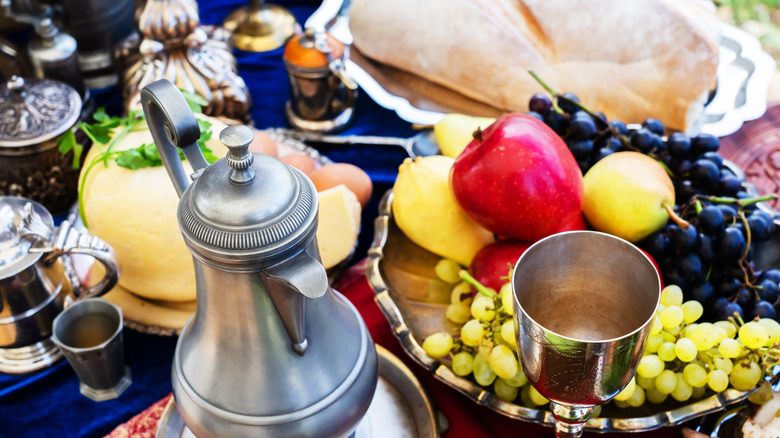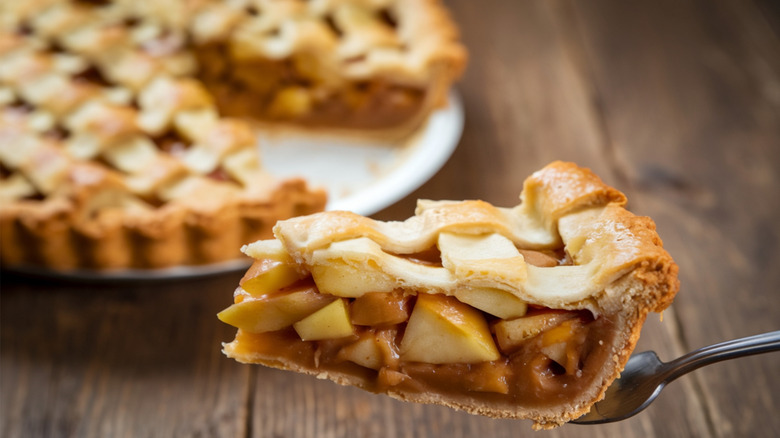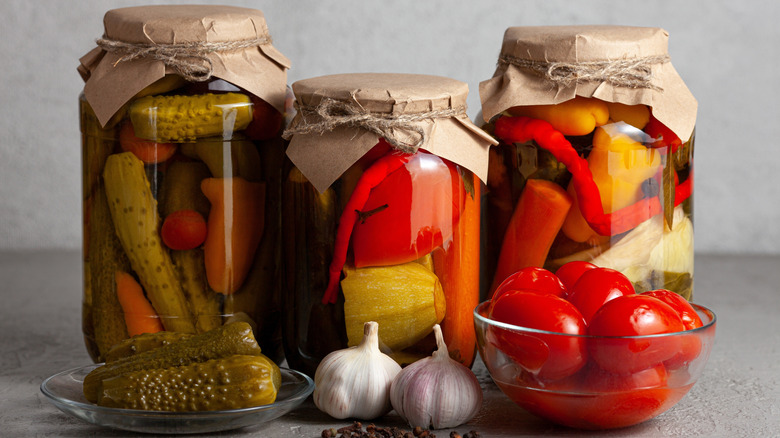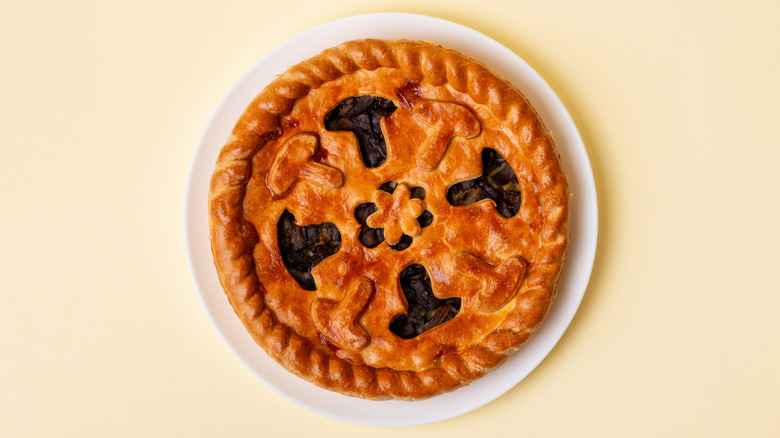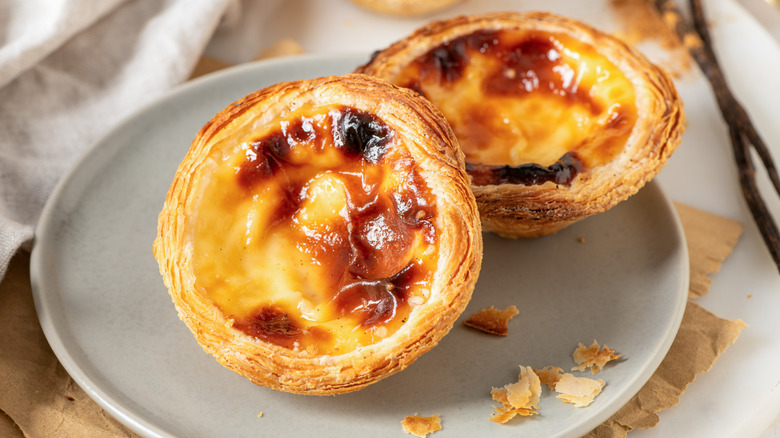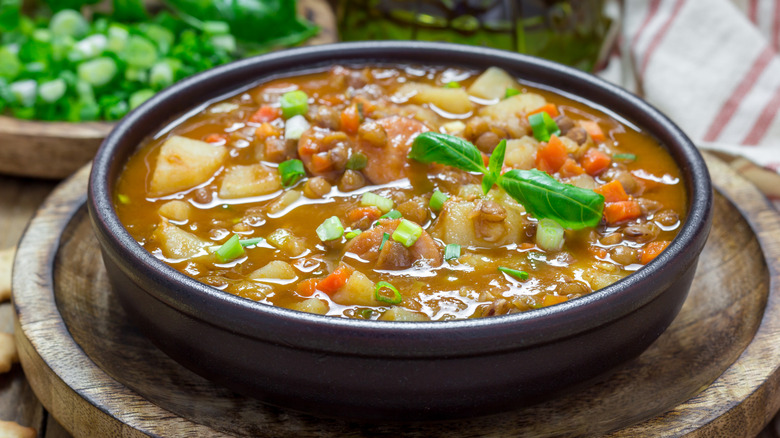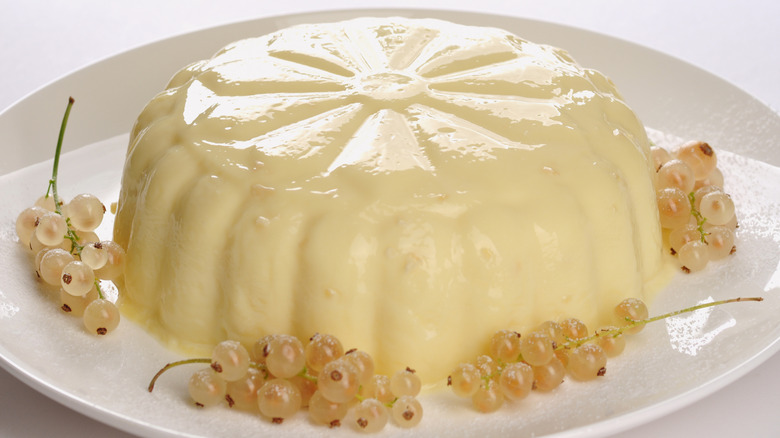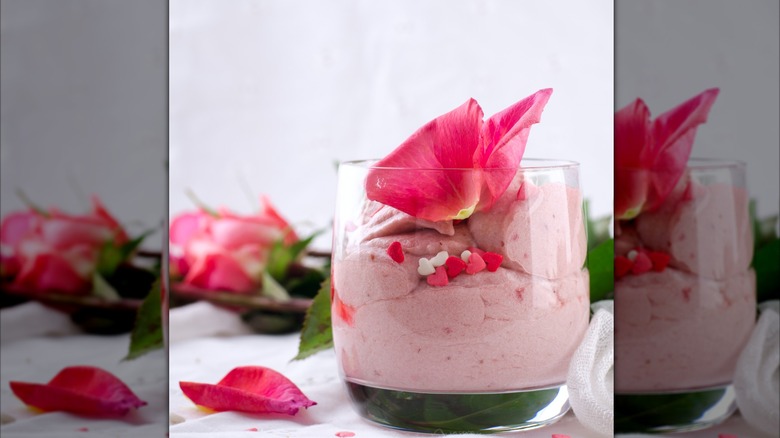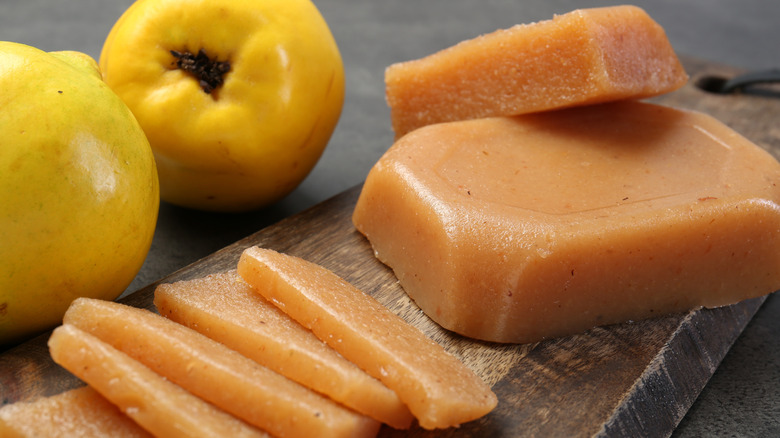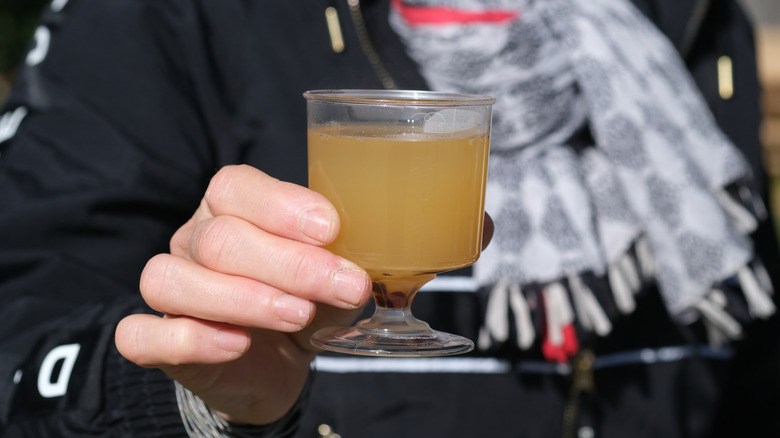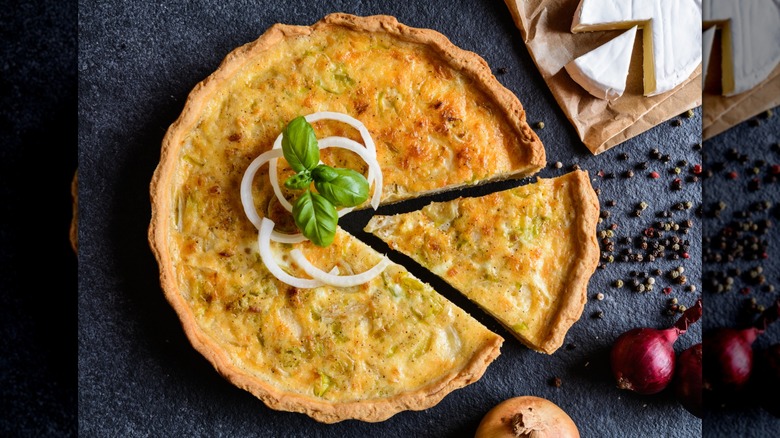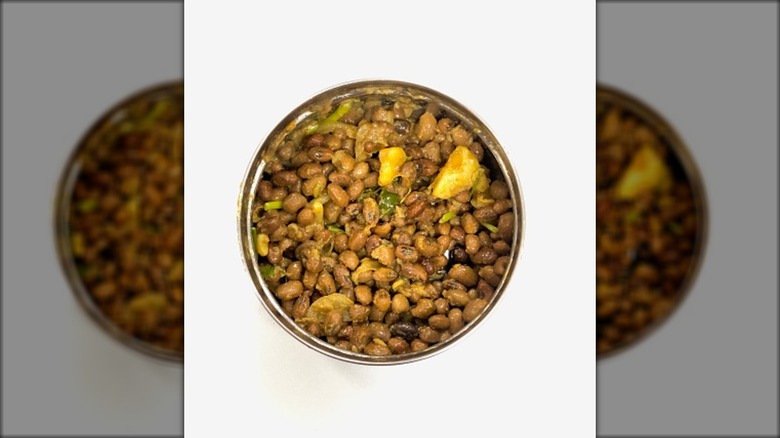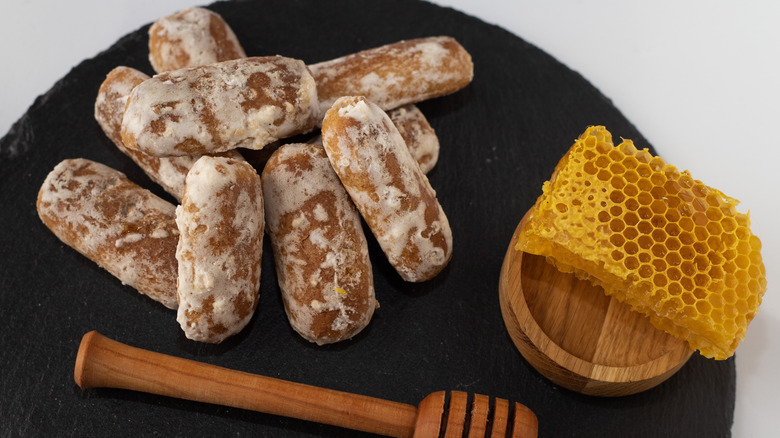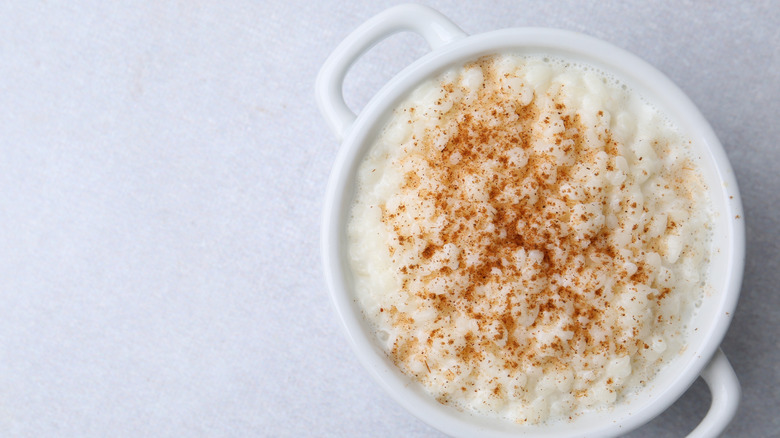13 Medieval Dishes That Still Hold Up Today
The medieval period — also known as the Middle Ages — lasted for around 1,000 years, between the 5th and 15th centuries. When you imagine what people might have been eating, you may think it would be quite unpalatable today. However, there are plenty of medieval dishes that still stand up in modern times.
You may be surprised by how many modern day dishes have their origins in the Middle Ages. Go back in time 1,000 years and you might be fed a dinner of pies, stews, and pudding. Sure, the recipes would have differed from ones popular today, but less so than most folks think.
We're about to go back in time to the Middle Ages and look at some foods, drinks, and dishes that people still eat today. You might not realize that one of your favorite meals dates back to the medieval era. Or perhaps you'll be inspired to try an archaic recipe or two on this list.
1. Apple pie
You've heard the phrase "American as apple pie" — well, the United States didn't even exist when the first apple pie was invented. The earliest recipe for apple pie comes from 1381. However, it's likely that it was eaten well before this. Though the oldest written European medieval recipes come from a document written in 1140, surviving recipe books are generally much older — books were rare and extremely expensive before the invention of the printing press in around 1440.
This early version isn't hugely different from the kind of easy apple pie recipe you might use today, though it has got more going on than just apple. It involves making a filling of apples, pears, figs, raisins, spices, and saffron, and cooking this inside a pastry case. There's also a recipe from the early 15th century, so the end of the medieval era, for an Italian apple pie or "torta", cooked for the court of Pope Martin V. This has a filling more consistent with apple pies today — just apples, honey for sweetening, and spices like cloves, nutmeg, and cinnamon. This was baked inside a thin pastry crust.
These are just a couple of examples of many early apple pies that would have been eaten in the Middle Ages. So, the next time you're craving a slice, remember that it isn't a new creation. Cooks in the medieval period laid the foundation for the dish you know and love today.
2. Pickled vegetables
People eat pickled vegetables all over the world, from your classic dill pickle to Turkish turşu to the pickled jalapeños you can buy in most supermarkets. But, you might not expect pickled veggies to have been part of a medieval meal. When you think more carefully, it makes sense that pickling was popular back then. It wouldn't just have been for flavor but to preserve fresh produce for use during the times of year when food would have been more scarce.
One pickled vegetable recipe from the Middle Ages calls for a mixture of parsley root (something not commonly eaten today), parsnips, radishes, carrots, cabbage, and pear. This was all pickled in vinegar with a range of spices for flavor: ginger, saffron, mustard, cinnamon, and black pepper. Sugar, honey, and wine were added to further flavor the lot. It's likely that everyday people would have eaten much simpler pickled vegetables, since many spices would have been expensive reserved for wealthy households. Still, this simple way of preserving would have allowed people to store food for the winter when fresh produce was harder to come by.
3. Mushroom pie
There's something curious about the use of mushrooms in the Middle Ages. Foraged mushrooms would have been a common food source, but you don't often find recipes for mushroom dishes written down. This is possibly because they were eaten more by the lower classes (aristocracy and wealthy classes may have seen fungus as a lowly food) and everyday folks wouldn't have written down recipes. For starters, most people weren't literate outside the elite, and even for the few who were, there wouldn't have been any call for these recipes to be written or any writings preserved.
So, it's interesting that we find a recipe for mushroom pies in a French medieval cookbook called "Le Ménagier De Paris" that was written around 1390. As with many recipes of around this time, there was a lot of assumed knowledge that we have now lost. Alongside mushrooms, the filling calls for spices, but the blend used isn't specified. Perhaps all cooks would have had their preferred blends.
The writer also instructs readers to add cheese inside the pastry, but no indication of which cheese. But, based on the cheeses available in France at the time, something like Comté or Gruyère is a good choice. Bake all this in pastry, and you have a dish most people would be happy to eat today.
4. Custards
If you think custard is a modern comfort food invention, think again — medieval cooks loved them as much as we do today. Custards (made from milk or cream, and eggs) turned up across medieval Europe as both sweet and savory dishes: the sweet versions were baked in pastry shells as what we'd now call egg tarts or custard tarts, while savory "crustardes" could include meat or fish. They were common enough to appear in many period cookbooks and show up in lots of regional variants.
Two of the best-known examples are the English daryols and the Italian diriola. The English version from the 1390 book "Forme of Cury" is wonderfully simple. It consists of cream (or almond cream), eggs, sugar, saffron, and a pinch of salt tucked into a pastry shell, which — fun fact — was known as a coffin back in the Middle Ages. The Italian recipe is a little more complex, adding cinnamon, rosewater, and sometimes fruit. Because recipes vary (and medieval writers often assume you know how to do this), there's plenty of room to adapt them to modern tastes.
A practical note from the period: custard can be fussy. Many medieval cooks baked the custard right in the shell (rather than thickening it on the stovetop) to avoid curdling, and writers warn that it should be set but still quiver when it's ready to come out of the oven — the same gentle wobble we prize in a good tart today.
5. Pottage
You couldn't throw a stone in the medieval times without hitting a bowl of pottage. It was something people really ate in the Middle Ages — but don't imagine just a single recipe. Pottage is a family name for dishes simmered in a pot. Depending on where you were and who was eating it, a pottage could be a humble vegetable kept on the hearth for days, or a more elaborate dish incorporating meats and spices. It's the sort of thing we still eat today — only now we call it stew or a thick, hearty soup.
The variety is what's fascinating. Surviving medieval collections list everything from pea and cabbage pottages to chickpea broths and beef stews — recipes that sound strikingly familiar when translated into modern ingredients and technique. Pottages were often thickened with grains, pulses, nuts, or breadcrumbs. The presence (or absence) of meat, imported spices, or almonds usually told you whether it was made for a peasant or a lord.
If you served a present day vegetable stew to someone from the Middle Ages, they'd still recognize it as a type of pottage, even if it was slightly different in the details. In some cases, the combinations of herbs and spices used are a bit different from what we might use today, but, basically, pottage is still around today as soups and stews.
6. Blancmange
You might be familiar with blancmange from kids parties or your grandmother's house — it's a kind of creamy Jell-O. But, did you know it dates all the way back to medieval times? The original dish was somewhat different and perhaps not quite as appealing to modern day palates. However, it's changed gradually over the years so that people are still interested today.
It was made using chicken, rice, almond milk, and sugar. The chicken was boiled and shredded finely, and the rice either milled to a flour or cooked until overly soft. It was all boiled together until it formed a kind of thick, moldable paste. This was one of those curious medieval dishes that was somewhere between a sweet and a savory dish. It contained chicken, but otherwise was a bit like a rice pudding.
Over the years, this adapted until it became a straight-up dessert — a kind of almond milk jelly. So, blancmange is still in rotation today, but the original medieval version might not tick the right boxes for most folks.
7. Rose pudding
Rose pudding — known as rosee in the medieval period — survives in sources such as the book "Forme of Cury," which was written in around 1390. It's something between a custard and a modern day pudding, made from almond milk thickened with rice flour (or ground rice) instead of relying on eggs, and flavored with real rose petals, plus warming spices like ginger and cinnamon. Pine nuts and chopped dates often turn up — the former seeming like an odd addition to a pudding these days, but adding an extra layer of flavor.
It's super easy to reproduce this recipe with a modern pantry. Almond milk was popular in the Middle Ages because abstaining from animal products for reasons of religious fasting was common. Back then, it would have been expensive and time consuming to make, but now you can simply buy a carton of almond milk from the store. Most of the other ingredients are easy to find in stores, and if you don't have any rose petals, you can pick up rosewater instead. Although rose isn't everyone's favorite flavor, for those who like it, this pudding is a real treat. It still stands up in contemporary times surprisingly well for a medieval dessert.
8. Quince connate
Quince connate (or just connate) might not be the kind of dish you come across today, but we can see how it would still stand up to a modern audience. Late-medieval recipes (preserved in collections like "Forme of Cury") instruct cooks to stew quinces in fat (historically white fat or lard), sweeten with honey, fold in egg yolks and almond milk, and flavor the whole thing with spice and saffron. The finished dish is a sliceable preserve or confection.
It's not totally clear how connate was enjoyed. Some sources talk about it being eaten with roasted dried fruits and nuts. It could also have been seen as a confection in its own right, a bit like Turkish delight or Lokum. But, in a modern context, it's most likely to be eaten in a similar way to quince paste: sliced and served with cheeses and crackers. It's the perfect way to appreciate the fragrant sweetness of quince.
9. Mead
Mead is a type of alcohol made by fermenting honey with water, sometimes with the addition of fruit, spices, herbs, or flowers. Where beer relies on grain and wine on grapes, mead's defining ingredient is honey, which gives it a huge flavor range, from delicate and floral to syrupy and richly spiced.
The history of mead dates back far longer than the Middle Ages. Chemical traces of honey-based fermented drinks appear in archaeological sites thousands of years old, and mead crops up in myths and literature from across Europe and Asia. In the medieval period, it was common at feasts, kept in household or monastic cellars, and often credited with medicinal properties. Medieval cooks and apothecaries flavored mead in many ways: metheglin (spiced mead), melomel (with fruit), and braggot (a blend of mead and malted grain) are all historic variations.
Although it's not nearly as popular as it was in the Middle Ages, some home brewers still make mead today. You can also find specialist producers still making mead. It's not the kind of thing you can pick up at every liquor store, but it's out there, if you know where to look. So, mead doesn't seem to be going anywhere.
10. Cheese pie
Cheese pies were everywhere in medieval kitchens. They turn up in almost every European cookbook from the period. Many manuscripts offer at least one version: some are almost custard-like (a bit like a present day quiche), others more like a savory tart, and a few sit somewhere between sweet and savory. Back in the medieval times, the lines were often blurred between sweet and savory dishes, so you could find cheese pie recipes that use herbs and sugar. While they would have had their own twist from the era, most folks today would happily eat a cheese pie or a cheesy quiche.
Recipes vary, but some have a pretty straightforward base filling of egg, cheese, butter, and flour. Medieval cooks may have dressed that up according to taste and budget, adding various herbs and spices. Recipes from this era rarely name a type of cheese, so modern cooks who want to recreate them have to guess. In the Middle Ages, there was a wide range of cheeses available, from cream cheese and other young cheeses like ricotta, to aged cheese like Parmesan, and blue cheeses and other mold-ripened varieties.
11. Fried beans
Beans would have been a staple in medieval meals — and sometimes they were served fried. There's a particular recipe called benes yfryed in "Forme of Cury" that calls for fava beans to be boiled until they're almost bursting, the water squeezed out, then fried with chopped onions and garlic in oil or fat and seasoned with poudre douce (a sweet spice mix). However, this seems like the kind of dish that would have existed in many forms and been eaten in households rich and poor.
The poudre douce is the medieval twist in this dish. It often contained ginger, nutmeg, cloves, and sugar. It seems like something that would be used only in sweet dishes today, but the medieval palate was slightly different. Still, fried beans are eaten today, whether it is the easy refried beans recipe common in Latin American cooking or something like a bean burger. It just goes to show that modern culinary sensibilities aren't all that different now.
12. Gingerbread
Gingerbread in the Middle Ages doesn't look much like the cookies we expect today. Medieval gyngerbrede is closer to a piece of candy. Recipes call for boiling honey, skimming it, adding saffron, pepper and other spices, then mixing in grated or stale bread until the mass is stiff enough to slice. Cinnamon is sprinkled on top, cloves are often stuck into each square as garnish, and sandalwood was used historically to colour pieces red.
Taste and technique-wise, medieval gingerbread is intensely honeyed, warmly spiced and quite chewy. The breadcrumb base in some recipes leaves the texture a little like a very dense cake depending on proportions. Spices at this time would have been all about status, so only wealthy folks would have been able to afford to make it.
Today, gingerbread is quite different, but this old version still holds up today. It's more like a sticky honey candy — intense but good in small pieces. Maybe it's a shame that this old-school version has mostly disappeared.
13. Rice pudding
Rice pudding was a familiar sweet dish in late-medieval England and appears in manuscripts used around Chaucer's time. The dish was known as rys at this time and would have only been eaten in the higher echelons of society, as rice was an expensive import in the Middle Ages.
A written recipe from 1420 instructs cooks to boil rice until tender, cool it, then simmer it in almond milk, sweeten with sugar and honey, and serve. There would have been various versions of this. Some may have used dairy milk and others could have incorporated spices, but this was the basic template. It's honestly not too different from the kinds of rice puddings served today, and modern folks would recognize it as such.
One difference is that it involves boiling the rice in water before milk. This may have made the rice break down more to give the dish a more cohesive, pudding-like texture. It also uses almond milk, which isn't typical today, but this would have made it a suitable dessert for religious fasting days, of which there were many in the medieval era. It's also notable that both sugar and honey were used: honey would have been a cheaper sweetener than sugar, as it was easy enough for households to keep bees and produce their own.
